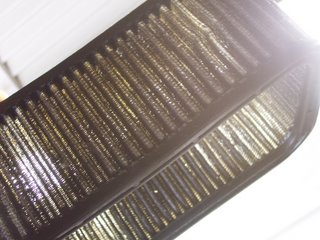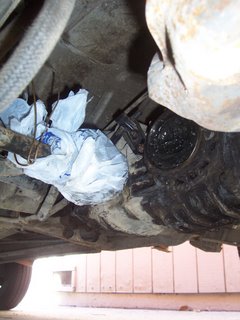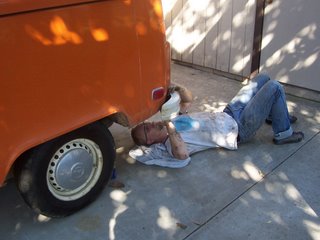As a result of the tranmission problems Ludwig incurred during the Death Valley trip, Mitch and I had to remove the drivetrain (engine + transmission) for repairs. VW engines and transmissions are oriented in such a way that it's easiest to remove the engine in order to remove and repair the transmission. As I remember it, this is how the whole event unfurled.
Pictured here is the carbeurator. This is where air goes into the engine to mix with gasoline (which eventually burns up to make Ludwig go). The carbeurator is where the "mixing" happens. It usually sits right on top of the engine and hooks up to the intake manifold. The carbeurator has to be removed because the engine is removed under the bus (instead of being lifted up and out). If the carbeurator weren't removed, it would make the engine much taller, but just in that one spot.
This is the air filter that is normally attached to the top of the carbeurator. An air filter should be clean enough so that when holding it up to light, you can see light through it (according to Mitch). As you can see, Ludwig's was filthy from the Death Valley trip, so he'll get a new one soon.
This is looking down at the engine from inside the body of the van. See the four long pipe looking things? Those are the intake manifolds. That's where the carbeurator is normally attached. There are four white rags plugging the openings. The gas-air mixture travels to the cyclinders via the intake manifolds.
Ok, now we're all done with the top of the engine, for now. Next up, we had to disconnect the transaxle. There's one one each side of the transmission attaching to each wheel. After several stubborn hex head bolts were removed, we covered the end of the CV (Constant Velocity) joint with a plastic bag, and wired it to the frame (using an old coat hanger). The greasy black round area is where it was attached. It is quite possibly the thickest blackest grease I've ever seen in my life. Then we did it again to the other side.
The next task was to remove the bumper. Since the drivetrain is removed under the bus, removing the bumper allows a few more inches of clearance.
Removing this oil filler tube gave us some extra clearance too.
Somewhere along the way (actually, it was at the beginning, starting with the battery), Mitch disconnected a bunch of wires, the fuel line, removed the engine seal and we both removed several other bolts attaching the engine and transaxle to the bus. As soon as everything was disconnected, Ludwig was jacked up and resting on jackstands and while the drivetrain was lowered on a different jack, Mitch had an epiphany. He realized why the exhaust should be removed when dropping an engine. The exhaust is quite protrusive, and really got in the way of maneuvering the engine. (The picture above shows how the muffler just sort of protrudes out.) We had come to far to turn back, so we just managed our best. (I didn't want to remove the exhaust unless we really had to, since it is a tremendous pain. We got it out with the exhaust attached, but I see now why one really should take it off.)
After a few minutes of head scratching, raising and lowering the jack and pushing and pulling the engine, Ludwig's drivetrain came right out.
The engine is what's mainly on the jack above. The more narrow hunk of metal on the front, just under Ludwig's tail, is the transmission. Although it looks as though the transmission is resting on the ground in the pictures, rest assured that it is not.
How heavy is Ludwig's drivetrain? Well, I was able to pull it into the garage with the jack completely unassisted, so it wasn't SO heavy.
And now my dear Ludwig waits, but we'll try not to keep him waiting too long.
Somewhere during the beginning of this event, Mitch was describing the process of engine removal to me with analogies, to help me better understand what was going to happen. He explained that removing an engine in most cars is like a moth emerging from a cocoon. Removing an engine from an air-cooled Volkswagen, or "dropping an engine" (because the engine is removed underneath), is more like the VW is giving birth. I just thought I'd share that.
(She skipped a few minor steps, but that's basically how it went.)









8 comments:
Great analogy, if it's name wasn't Ludwig. Are you sure it's a male? I love that you named your vw's. People just think i am weird when I try to tell them that cars can be male or female and that they have personalities.
Great discriptions. I learned a lot about cars in general from reading this post.
doreen-
Yes, he's male. Trucks, SUVs and vans are male, sedans, sports cars and station wagons are female. (El Caminos and Rancheros are hermaphrodites.) How does a male VW "give birth"? I guess they're like seahorses. Or maybe the analogy is a little flawed.
I've named all my cars, and even some other people's cars. That includes the two non-VWs I've owned, a 1977 Mustang (Yvette) and our 1995 Subaru (Fang Fang).
-Mitch
the frog-
Thanks! I'm glad it made sense. I'm learning alot about how engines work from helping Mitch with this kind of stuff. This type of VW maintenance is much more interesting to me as I learn more about what's what.
-Melissa
I don't go by what the car is to name it. It's just a feeling I get as to whether it's male or female. I guess i m fruitier than some or most. Dr. J would say I was eccentric. We have a ford explorer that is without question female. Even though it looks male. She keeps going no matter what. We also have a Toyota solara, this car has woman written all over it. but it’s male and young. So now you know that Dr. J didn’t get her brains from me. I should ask her if her car is male or female and see what she say’s. I like ludwig. He’s cute.
Thanks for sharing the pics of your progress. Ludwig is truly "at rest" for the moment. He is anxiously anticipating his next great adventure! Perhaps he thought Death Valley sucked and went on strike?
MamaLynn
Dropping and engine, dropping a calf... what's the dif?
MamaLynn-
Mitch thinks that Ludwig liked Death Valley so much that he didn't want to leave.
-Melissa
hey guys. when do we get to here 'bout Ludwig's being healed?
Craig
Post a Comment